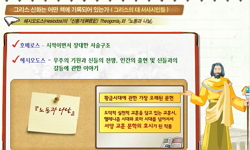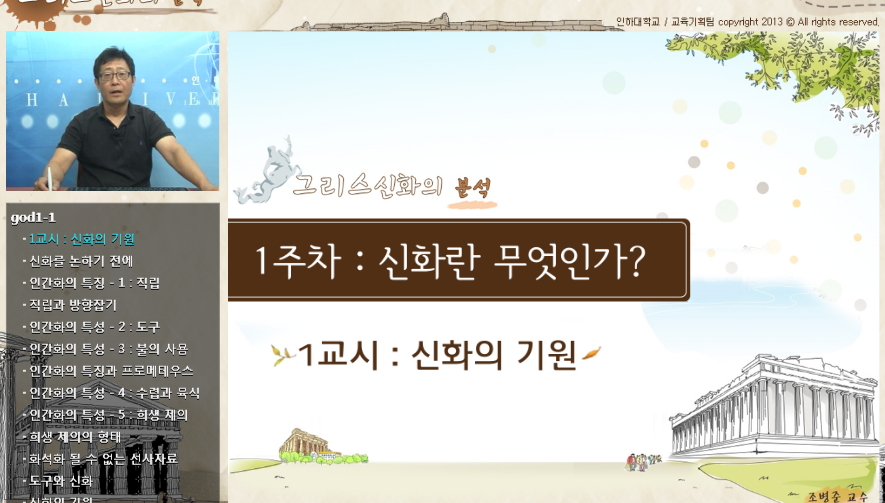The articles on three generations of Dan-Kun (Hwan-In, Hwan-Ung, Dan-Kun) were recorded in 'SamGukYuSa(三國遺事)', 'JeWangUnGi(帝王韻記)', 'SeJong SilLokJiRiJi(世宗實錄地理地)', and etc. In this paper, 'SamGukYuSaKoGi(三國遺事 古...
http://chineseinput.net/에서 pinyin(병음)방식으로 중국어를 변환할 수 있습니다.
변환된 중국어를 복사하여 사용하시면 됩니다.
- 中文 을 입력하시려면 zhongwen을 입력하시고 space를누르시면됩니다.
- 北京 을 입력하시려면 beijing을 입력하시고 space를 누르시면 됩니다.

단군(檀君) 삼대(三代) 신화(神話)의 재조명(再照明) = A Mythological Contemplation on the Articles of Three Generations of Dan-Kun
한글로보기https://www.riss.kr/link?id=A45004760
-
저자
황패강 (단국대학교)
- 발행기관
- 학술지명
- 권호사항
-
발행연도
2004
-
작성언어
Korean
-
주제어
단군 ; 삼대 ; 환인 ; 환웅 ; 신화 ; 상실 ; 회복 ; 혼돈 ; 천부인 ; 신단수 ; 성산 ; 신시 ; 성시 ; 제정(祭政)의 성역(聖域) ; 문화영웅 ; three generations of Dan-Kun ; Hwan-In ; Hwan-Ung ; myth ; mythology ; the original loss ; the passion for the corresponding recovery ; losmic tree ; sacred city ; culture hero ; 桓因 ; 桓雄 ; 混沌 ; 天符印 ; 神壇樹 ; 聖山 ; 神市 ; 聖市 ; 文化英雄
-
KDC
810.000
-
등재정보
KCI등재
-
자료형태
학술저널
- 발행기관 URL
-
수록면
51-63(13쪽)
-
KCI 피인용횟수
1
- 제공처
- 소장기관
-
0
상세조회 -
0
다운로드
부가정보
다국어 초록 (Multilingual Abstract)
The articles on three generations of Dan-Kun (Hwan-In, Hwan-Ung, Dan-Kun) were recorded in 'SamGukYuSa(三國遺事)', 'JeWangUnGi(帝王韻記)', 'SeJong SilLokJiRiJi(世宗實錄地理地)', and etc. In this paper, 'SamGukYuSaKoGi(三國遺事 古記)' is referred as a primary source whereas the rests are considered as subsidiary references. Even though the history of Dan-Kun(檀君) has been investigated for years, the references mentioned above describe the prehistoric story of the universe and human in a form of mythology. This issue necessitates the mythological interpretations of the references rather than historical interpretations. Accordingly, mythological interpretation of three generations of Dan-Kun(檀君) is summarized as follows.
First generation: Hwan-In::: According to 'KoGi(古記)', 'Hwan-In(桓因)' is described as 'Je-Suk(帝釋)' - which is same as an old Indian god - who lived in a heaven called 'Do-Ri-Chun' on top of 'Su-Mi(須彌)' mountain, and controlled thirty three heavens. However, 'Je-Suk(帝釋)' is a figure adopted from Buddism, which corresponds to 'Hwan-In(桓因)', considering its functionality and characteristics. It is called 'Sang-Je-Hwan-In(上帝桓因)' in JeWangUnGi (帝王韻記). Traditionally, in Korean and Chinese culture, the supreme god who dominates universe has been named as 'Ok-Hwang(玉皇)', 'Chun-Je(天帝)', and 'Sang-Je(上帝)' whose shapes and individuality are not supposed to be described. Basically, He does not move around or vacate his position at the center of universe. Hwan-In(桓因) is the supreme god as such.
Second generation: 'Hwan-Ung(桓雄)'::: As an illegitimate son of 'Hwan-In (桓因)', he was concerned with mankinds ('Sag-Ui-Chun-Ha 數意天下') and devoted himself to save them ('Tam-Gu-In-Se 貪求人世'), which was noticed by 'Hwan-In'. Having three 'Chun-Bu-In(天符印)' provided by 'Hwan-In', he led three thousand people and descended from heaven to 'Sin-Dan-Su(神壇樹)' on top of 'Tae-Baek(太伯)' mountain. He commanded 'Pung-Baek(風伯)', 'Woo-Sa(雨師)', and 'Woon-Sa(雲師)' who are in charge of agriculture. He controlled crops, life and death, illness, punishment, and good and evil to establish fundamental systems of human society. Also, he managed 360 kinds of human business. Considering these fact, even though he was a god, he shares the similarity of mythological (or cultural) anti-god heroes who positioned himself from divine side to human side, and served for human beings. His admiration of divine world may be related to his status as an illegitimate son. Since he obtained the permission from his father 'Hwan-In(桓因)' and followed his order to descend from heaven, he has to be differentiated from other ethnic-mythological divine heroes who were expelled from divine society as a punishment or who escaped to human world for his faulty behavior.
Third generation: Dan-Kun(檀君)::: His final grand mission was to deliver Dan-Kun(檀君), - a demigod and culture hero - who brought civilization and orders to human beings. Hereby, he performed the first marriage of mankind and delivered the forefather of human beings.
The mythology of three generations of Dan-Kun(檀君) represents the fate of a human who departed from paradise symbolized as heaven. Hwan-Ung(桓雄) is similar to Adam and Eve as a symbol of original human beings who lost their paradise. Although, the latter lost the paradise forced by others, but Hwan-Ung(桓雄) decided to lose the paradise by his own will. However, human beings are destined to lose their paradise either willingly or unwillingly since they are human. Humans in Paradise Lost cannot abandon the hope for Paradise Regained. The descendants of Hwan-Ung(桓雄) who chose to leave paradise in heaven long time ago, keep nostalgia for paradise far from the earth, and are yearning for returning. The mythology of three generations of Dan-Kun(檀君) implies the original loss by our nation (or mankind) residing deep inside of the consciousness, and the passion for the corresponding recovery.
목차 (Table of Contents)
- 1. 머리말
- 2. 단군(檀君) 삼대(三代)의 신화적(神話的) 성격
- 3. 단군(檀君) 삼대(三代) 신화(神話)의 의미
- 1. 머리말
- 2. 단군(檀君) 삼대(三代)의 신화적(神話的) 성격
- 3. 단군(檀君) 삼대(三代) 신화(神話)의 의미
참고문헌 (Reference)
1 "한국서사문학연구" 단국대 출판부 1972
2 "천신숭배사상:한국의 민속사상" 집문당 1996
3 "일본신화의 연구" 지식산업사 1996
4 "a mordern abridgment by E" Bulfinch Dell Publishing Co 1963
5 "The Myth of the Eternal Return from the French by Willard R" 1959
1 "한국서사문학연구" 단국대 출판부 1972
2 "천신숭배사상:한국의 민속사상" 집문당 1996
3 "일본신화의 연구" 지식산업사 1996
4 "a mordern abridgment by E" Bulfinch Dell Publishing Co 1963
5 "The Myth of the Eternal Return from the French by Willard R" 1959
동일학술지(권/호) 다른 논문
-
- 국어국문학회
- 최형용
- 2004
- KCI등재
-
- 국어국문학회
- 渡邊直紀
- 2004
- KCI등재
-
- 국어국문학회
- 남풍현
- 2004
- KCI등재
-
- 국어국문학회
- 구인환
- 2004
- KCI등재
분석정보
인용정보 인용지수 설명보기
학술지 이력
| 연월일 | 이력구분 | 이력상세 | 등재구분 |
|---|---|---|---|
| 2020 | 평가예정 | 계속평가 신청대상 (등재유지) | |
| 2015-01-01 | 평가 | 우수등재학술지 선정 (계속평가) | |
| 2011-01-01 | 평가 | 등재학술지 유지 (등재유지) |  |
| 2009-01-01 | 평가 | 등재학술지 유지 (등재유지) |  |
| 2007-01-01 | 평가 | 등재학술지 유지 (등재유지) |  |
| 2004-01-01 | 평가 | 등재학술지 선정 (등재후보2차) |  |
| 2003-01-01 | 평가 | 등재후보 1차 PASS (등재후보1차) |  |
| 2002-01-01 | 평가 | 등재후보학술지 유지 (등재후보1차) |  |
| 1998-07-01 | 평가 | 등재후보학술지 선정 (신규평가) |  |
학술지 인용정보
| 기준연도 | WOS-KCI 통합IF(2년) | KCIF(2년) | KCIF(3년) |
|---|---|---|---|
| 2016 | 0.79 | 0.79 | 0.75 |
| KCIF(4년) | KCIF(5년) | 중심성지수(3년) | 즉시성지수 |
| 0.72 | 0.72 | 1.376 | 0.3 |




 DBpia
DBpia







